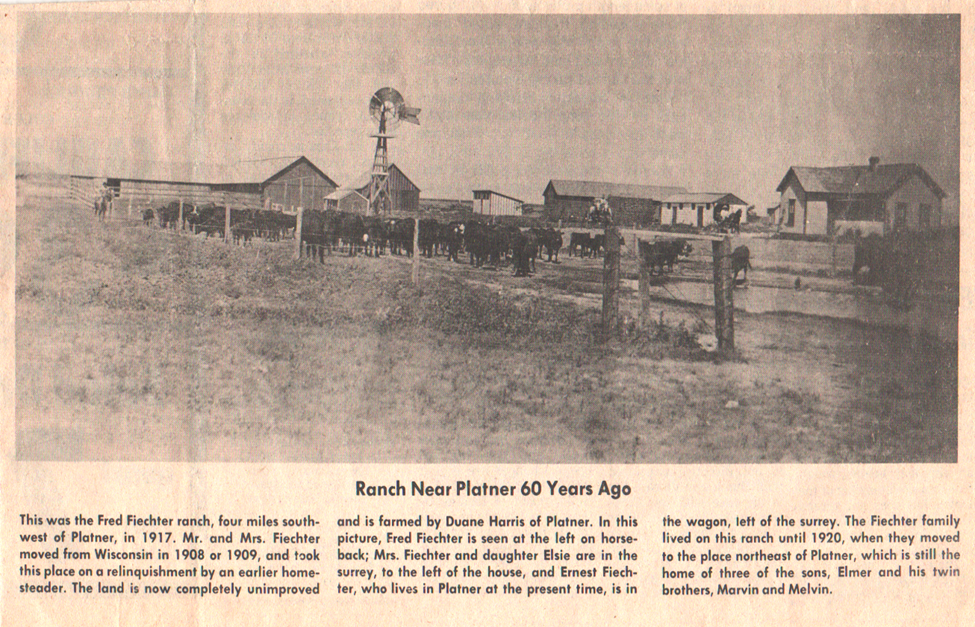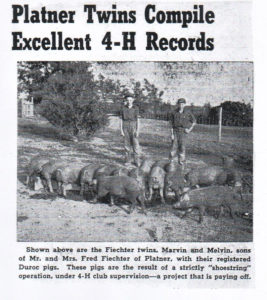A version of this story was previously published in the Otis Telegraph and the Akron News-Reporter. With thanks to Carole Salter for providing the family history included in this story.
On a plot of land in the plains of Eastern Colorado, a family legacy stretching back 114 years grows alongside fields of grain cultivated for decades by a pair of quiet but dedicated twin brothers. Starting this year, 4-H youth in Washington County will join in on that legacy. Twin brothers Marvin and Melvin Fiechter did not leave any children behind when they passed away. Through the new Fiechter Memorial Fund, established by their family, their name will be carried on by youth across the county they called home for their entire lives.

A homestead on the plains

The story of the Fiechter Family is like that of so many in Colorado’s farming and ranching communities. It extends across decades and centuries, and through pivotal moments in state and national history that now fill history books in classrooms. In 1908, Frederick Fiechter purchased a one-half section of homestead relinquishment southwest of Platner, CO, with his brother Samuel after hearing about farmland available in the West. Another brother, Alfred, soon followed, settling near Otis to farm and raise his family. These were three of four brothers from a family of ten who emigrated to America from Switzerland in 1904. While Samuel eventually sold out and moved on, Fred began to build his life in Washington County.
Soon after arriving, Fred met Lena Ehrman, whose family owned a nearby farm. Romance budded, and in April of 1910, they were married. Together, Fred and Lena farmed the “Section Place” as it came to be locally known. Changes were afoot for the couple, marked by both the heartache and joy that characterize life on the homestead. Fred became a citizen in 1917; by 1920 they had moved northeast of Platner to a five-acre plot of land. They welcomed seven children during this time: Ernest and Elsie were born at the Section Place, Elma and two sets of twins were born on the farm northeast of Platner. Twins Elmer and Elinor were born in 1925, though sadly Elinor passed away at two-and-a-half years old. Twins Marvin and Melvin were born in December 1932 and would spend the rest of their lives living and working on what was to become the Fiechter Brothers’ Farm.
“You would never know the story of these men”
In 2021, Washington County Extension Agent Jamie Axtell, who specializes in 4-H Youth Development and Livestock, got a call from a woman with a story – and an idea.
“Platner is this little community that sits right in the center [of] our county,” Axtell recalled. “There were these two gentleman that lived in Platner: never married, never had kids, worked hard on the farm all their lives. I never met them. My husband used to work at the bank, and they would come through, and he said you would never know the story of these men. They just looked like average farmers.”
But every farmer in Washington County has a story, so often humble and hidden from view. Marvin and Melvin were no different. Axtell learned theirs through conversations with one of the Fiechter brothers’ nieces, Sharon Schulze.
 Their father Fred had established an irrigated truck farm to grow vegetables, plants, fruit trees and various other trees that he marketed. The farm became a showplace, with a system of irrigation ditches that were supplied with water pumped from a 92-foot well and stored in a 30-barrel supply tank that provided gravity-fed water as needed. This storage tank still stands today. While most of his crops were income producing, he also grew some novelties. He exhibited from these at fairs throughout the area; at one fair he showed 67 samples of fruits, vegetables and grains. In just four years, Fred acquired 210 fair prizes. He also grew many varieties of flowers and some field crops on small plots to give variety to his exhibits. To ensure pollination, he maintained a few colonies of bees and marketed the surplus honey. A storage cellar enabled him to hold many of the fruits and vegetables over winter by burying them in sand. Finally, chickens and goldfish completed the output of the five-acre homestead. On an additional 200 acres of farmland, he produced corn, wheat and pinto beans as cash crops. Growing up on the farm, Marvin and Melvin were exposed to his creative approaches and connected to the culture of county fairs.
Their father Fred had established an irrigated truck farm to grow vegetables, plants, fruit trees and various other trees that he marketed. The farm became a showplace, with a system of irrigation ditches that were supplied with water pumped from a 92-foot well and stored in a 30-barrel supply tank that provided gravity-fed water as needed. This storage tank still stands today. While most of his crops were income producing, he also grew some novelties. He exhibited from these at fairs throughout the area; at one fair he showed 67 samples of fruits, vegetables and grains. In just four years, Fred acquired 210 fair prizes. He also grew many varieties of flowers and some field crops on small plots to give variety to his exhibits. To ensure pollination, he maintained a few colonies of bees and marketed the surplus honey. A storage cellar enabled him to hold many of the fruits and vegetables over winter by burying them in sand. Finally, chickens and goldfish completed the output of the five-acre homestead. On an additional 200 acres of farmland, he produced corn, wheat and pinto beans as cash crops. Growing up on the farm, Marvin and Melvin were exposed to his creative approaches and connected to the culture of county fairs.
Through farm and fair life, Marvin and Melvin eventually connected with 4-H. They raised cattle and registered Duroc pigs, starting in their early teens on a shoestring budget and with the support of local 4-H leaders. Throughout their young lives, they showed their livestock at fairs and won many ribbons and prizes, including a Grand Champion at the Washington County Fair in 1951 for Fat Barrow. After graduating from Akron High School, they served two years in the U.S. Army before moving home to live out their lives on the farm.
But the Fiechter twins were building something that would outlast them, just as their father had. As Axtell learned from Schulze: “They worked so hard, they had done really well for themselves. One of them liked to bowl, but other than that, they just spent their days on the farm.”
Looking for a place to start, Schulze reached out to Axtell with an idea. Axtell recalled: “Of course, I didn’t really know any of this [about Marvin & Melvin’s story] and one day out of the blue I received a phone call from one of the relatives… that was kind of elected to take on the task of finding some way to maybe leave something to the community in the name of the brothers.”
“We want to remember they were here”
Axtell, who also grew up in rural Colorado, knows how important preserving family legacy is. “As families that have traditionally been here move away, some of them are replaced by families that have never had the history of our county, and they don’t know that was the Fiechter place. They don’t know that there was somebody who lived there who did these things. So, without these men [Marvin & Melvin Fiechter] being there, we still want it to be known as the Fiechter place, and we still want to remember they were here… As we started talking through it, it really became apparent that what [Schulze] was talking about is simply everything we do in 4-H: community service, giving back, engaging with our community.”
4-H proved to be a connection not just between the twins and their community, but across family generations. Schulze, along with her sister Carole Salter and brother Terry Jackson, have fond memories of growing up as 4-Hers, from Schulze learning to sew her first apron with help from her mother to both women breaking out into giggles remembering how much they loved 4-H square dances.
“For me, [4-H] was my main outlet other than school and church,” said Schulze. “That was all we had, and I think it was for the boys [Marvin & Melvin], too. As soon as they were old enough, they started raising pigs, and we learned through some articles we found that they won a sheep at the County Fair, and they raised and then showed it later on for 4-H.”
Through this experience, a community finally has the chance to connect with a story that two hardworking and quiet brothers never told.
“Melvin and Marvin, you know, never really talked a lot about it, I guess,” said Schulze. “But then as we’re going through their stuff after they’re gone, we’re finding all these 4-H books and all these awards and all these things, and I wish I had kept more.”
“An encouragement for kids to help people”
Schulze and the rest of the cousins felt clear that they wanted this gift to positively impact youth.
“If the kids can come up with a project that they could present, that helped the community or helped service members or older people, it would be a chance to reward kids for thinking of patriotism and thinking of the country,” Schulze described. “It was an encouragement for kids to think of projects that would help people.”
Axtell feels proud of how the fund will honor the brothers’ contributions, too: “They made a sacrifice for our country and our community [serving in the Army], so this was an easy way for us to thank them for that.”
Building on a legacy of generosity, dedication and humility
Honoring these goals, the Fiechter Memorial Fund will carry on the family name by awarding prizes to individual 4-Hers and 4-H clubs for community service projects. Additionally, it will ensure that the graves of veterans across Washington County will be decorated for Memorial Day. Held by Colorado State University, the fund was created by gifts from nieces and nephews of Marvin and Melvin and their families: Ivan and Frances Fiechter, Carole and Errol Salter, Sharon and Gale Schulze, Donna and Fred Steckman, Terry and Laura Jackson, and Judy Sasse.
There are eight 4-H clubs across the county, with about 130 youth enrolled each year. With the Fiechter Memorial Fund now open, the legacy of Marvin and Melvin Fiechter will benefit hundreds of youth, as the 4-Hers of today honor and build on the generosity, dedication and humility of the 4-Hers of yesterday.
That’s the message Axtell hopes community members and 4-H youth take to heart: “A small gift can reach a lot of people. I think sometimes people think they don’t have a big amount of money to give to something like the 4-H program. It’s a gift of time, or sometimes just a gift of reaching out with an idea. How can we honor these men? How can we work with our heritage, honor our history, honor the citizens of our community?”
Thanks to the generosity of six cousins, the diligence of two brothers, and 114 years of family history, the answer will inspire youth for years to come.
To learn more about Washington County 4-H programs and events, visit www.goldenplains.extension.colostate.edu/programs/4-h-youth-development/washington-county